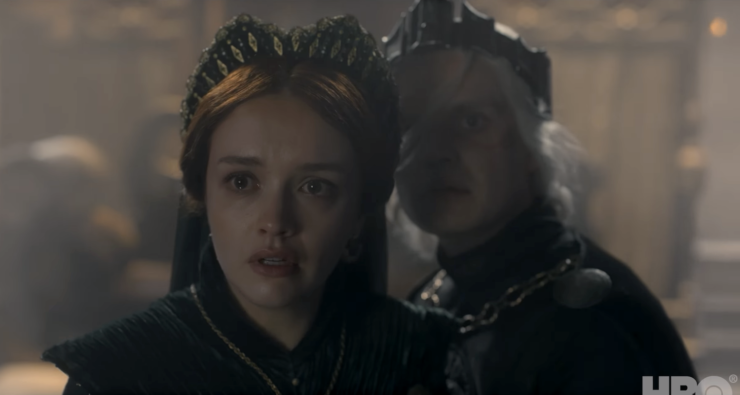The finale of this first season of House of the Dragon features the other half of last week’s episode with a focus on “the Blacks” (though no one has officially given Rhaenyra’s supporters that name). Though much of its runtime is focused on Rhaenyra’s (Emma D’Arcy) attempts to delay a war in light of Aegon II’s (Tom Glynn-Carney) usurpation, it builds to the point of no return where conflict is inevitable, ensuring that season two will be a bloody affair. In the first part of this article, we’ll look at some of the lore behind the episode.
Nearly three years after the divisive finale of the original Game of Thrones series, I feel comfortable saying that House of the Dragon feels carefully designed to try and replicate what made the original series great while also pivoting away from its flaws, both in front of and behind the camera. This new series focuses on a central story that is much more compact and more intimate in scope while retaining the budget of the previous show’s latter seasons, putting it to good use with more elaborate production design and some of the best looking dragons on either the big or small screen. As this inaugural season of House of the Dragon comes to a close, let’s look at some of the things that made this first season such a triumph and also where we could potentially see improvements in future seasons…
The Title
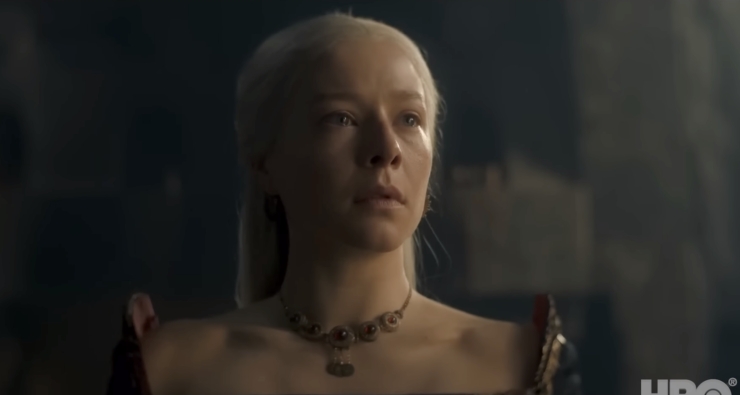
Arguably, Rhaenyra doesn’t become the eponymous “Black Queen” until the last seconds of the episode. And, as stated above, the Greens are a named faction in the world of the show, whereas their opposing faction have still not been christened “the Blacks” outside of the published source material. Nevertheless, the final moments of this first season—in which Rhaenyra, rocked by grief and fury at the death of her son, Lucerys (Elliot Grihault), gives the camera a look of wroth determination—are a flash-forward in time. History, according to Archmaester Gyldayn, the centuries-removed narrator of George R.R. Martin’s Fire & Blood, does not remember the legacy of Rhaenyra Targaryen kindly and this is the inflection point where she turns into a ruler fueled not only by duty and stewardship, but by vengeance as well. The show has been careful to lend nuance to the majority of its characters and, certainly, the sobriquet “the Black Queen” will be something more dire and unfair than Rhaenyra ultimately deserves, but here we see the origin story that will lead to some students of Westerosi history (like Gyldayn) regarding her with fear and revulsion.
Buy the Book
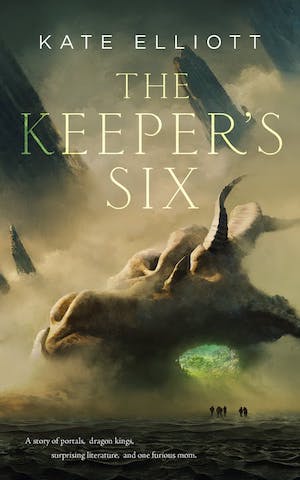

The Keeper’s Six
Additionally, it is telling that the finale is called “the Black Queen” whereas episode nine was titled “the Green Council.” The Greens are a group of people and represent a cluster of interests: Otto Hightower’s (Rhys Ifans) ambition, Alicent’s (Olivia Cooke) fear for her children, Criston Cole’s (Fabien Frankel) desire for petty revenge, and a cross-section of Westerosi nobility’s inability to accept a woman as their absolute monarch. On the other hand, the Blacks are organized around the singular righteousness of Rhaenyra Targaryen’s claim and backed by her own conviction that she must be Queen if Westeros is to stand against the White Walkers.
Visenya Targaryen and Monstrous Miscarriages
This episode features Rhaenyra giving birth, prematurely, to a stillborn daughter. It closes the loop on Targaryen heir stillbirths, with a funeral scene that echoes the one in the first episode for Rhaenyra’s mother, Aemma (Sian Brooke), and her stillborn brother, Baelon. Though the daughter is unnamed in the show, Archmaester Gyldayn reports that the child was named Visenya Targaryen after Aegon the Conqueror’s elder sister—rider of Vhagar and wielder of Dark Sister, the sword currently used by Daemon (Matt Smith).
The show gives us only glimpses of Visenya’s body and there look to be some malformations, but it is a far cry from what Mushroom, Rhaenyra’s court fool and one of Gyldayn’s sources, tells us about the child. In Fire & Blood, Visenya is described as having a hole where her heart should have been, a body covered in scales, and a stubby, draconic tail. This itself references a recurring magical malady in which numerous stillborn Targaryen infants are said to be born with draconic birth defects. In Martin’s A Game of Thrones, and in the finale of the original series’ first season, Daenerys Targaryen gives birth to Rhaego, her son with Khal Drogo, who is born with bat-like wings, scales, a tail, and flesh infested with grave worms as though he had been dead for years. Daenerys never sees Rhaego before he is taken away, simply taking the word of her treacherous midwife, Mirri Maz Duur, and, of course, Gyldayn writes his histories based on unreliable sources, so these may be exaggerated descriptions. But it does speak to the ways in which the Blood of Old Valyria, especially Targaryen blood, is suffused with a kind of dark magic that accounts for their resistance to fire, their ability to bond with dragons, and their exceptional, acquisitive nature that is variously perceived as a species of boldness or madness. These unfortunate stillbirths can, perhaps, be seen as the cost of all those Valyrian spells woven into their bloodline.
Unreliable Narrators: The Death of Lucerys Velaryon
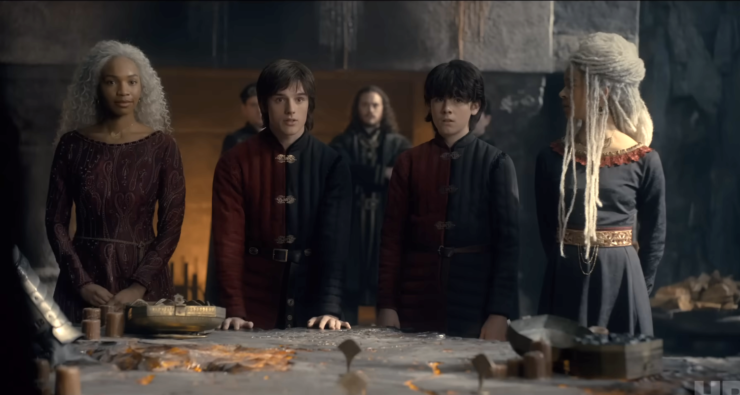
One last time this season, House of the Dragon takes a moment of unclear history from Gyldayn’s narrative as presented in Fire & Blood and offers the audience a nuanced twist. Much of the season finale follows events unfolding as exactly as Martin wrote them, with Lucerys having arrived too late to Storm’s End and Lord Borros Baratheon (Roger Evans) deriding him for not offering his hand in marriage to one of his daughters. With so many witnesses, Gyldayn’s account of Aemond Targaryen (Ewan Mitchell) tearing off his eyepatch to reveal the sapphire he kept in its socket and demanding that Luke give up an eye in recompense for having removed Aemond’s six years prior, before both second sons are ushered into the courtyard so as to not spill blood under Lord Borros’ roof, all are taken as verifiable and true. But, because Aemond Targaryen gives no written account of what happens next, Martin, through Gyldayn, writes only that “watchers on the castle walls saw distant blasts of flame and heard a shriek cut the thunder. Then the two beasts were locked together, lightning crackling around them. Vhagar was five times the size of her foe, the hardened survivor of a hundred battles. If there was a fight, it could not have lasted long” (Fire & Blood 421).
Gyldayn goes on to throw out a number of theories given by various sources: that Aemond found the fallen Lucerys and mutilated him, cutting out his eyes; that Lucerys survived the fall but the trauma of it had given him amnesia and he spent the rest of his long life as a fisherman; that Aemond brought the body to his new bride-to-be and that the two made love with the corpse at the foot of their bed. In the end, however, Gyldayn asserts the truth he believes is most accurate: that, though Lucerys Velaryon’s body was never found, he perished alongside his mutilated dragon, Arrax, during that fight.
The show offers a clever twist here. The point of departure is not what happens to Lucerys Velaryon in the end, but what happens to both he and Aemond during their altercation. With Arrax spooked and Vhagar simply too big to control under all circumstances, the show posits that Arrax attacks Vhagar and the older dragon retaliates, all while their riders desperately try to pull each other back from the brink. Aemond means to scare his nephew, not kill him. Lucerys means to flee the encounter, not engage. It works as a microcosm of the story the whole show has been telling: multi-generational hatred, if not addressed and corrected directly, festers and blossoms in unexpected ways. Alicent instills a fear and hatred of Rhaenyra in her children that outstrips her own, complicated feelings for her former friend. In turn, Aemond’s loathing of Luke, though rooted in the loss of his eye and a series of perceived slights, gets communicated to Vhagar who has no understanding of the horrors that will be unleashed as the result of Lucerys’ death. Aemond’s panic above the clouds, watching Arrax’s bloody remains spiral back down to earth, is one of the few moments of vulnerability the character has as he realizes the cataclysmic consequences of his actions, now that he has inadvertently escalated the war. It’s a stunning end to the season: tragic, monstrous, and visually stunning.
Odds and Ends
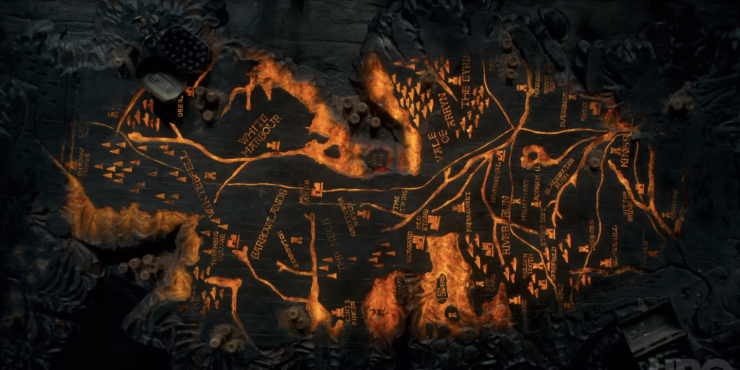
Dragonstone and the Painted Table
In Martin’s books, Dragonstone is described as being a castle unlike any other in Westeros—largely because every surface of it is carved with stone dragons and other fearsome beasts. As Stannis Baratheon’s daughter, Shireen, and her fool, Patchface, wander the gargoyle-encrusted halls, Martin refers to the sense of menace contained within the walls. Some of those carvings are so realistic that Stannis’ priestess, Melisandre, in misreading the prophecy of the Prince That Was Promised, believes that she can use blood magic to bring the beasts to life. Saddled with the scaled-back, geometric design of the original show’s vision of Dragonstone, our first real look at the castle on House of the Dragon doesn’t match Martin’s vision. But the production designers have done great work in making the brutalist walls sit at unsettling angles and giving the stonework a decidedly non-European design that, at various moments, is reminiscent of Mayan, Cambodian, and Malian designs. This also puts it in line with the monolithic walls and pyramids of Viserys’ model of Old Valyria (as seen in the show’s opening credits).
Likewise, the Painted Table—a map of Westeros in Aegon the Conqueror’s old War Room—has gotten an upgrade from the original series. Now, instead of merely being a combination table and map, it is carved, partially, from translucent stone, allowing candles to be placed beneath it, illuminating the names, rivers, and contours of Westeros’ various features with an eerie firelight. Much like the expanded Iron Throne, the re-hilted catspaw dagger, and the dark, ferrous skull of Balerion the Black Dread, the Painted Table’s illumination marks an attempt by showrunners to inject a kind of lost history in this prequel, simultaneously driving home the magnificence of the Targaryen dynasty’s golden age and bringing some key design elements more in line with Martin’s original vision.
Vermithor
The giant, bronze dragon that Daemon coaxes out of nesting beneath the Dragonmont is Vermithor, one of two huge, unclaimed creatures that make their home on Dragonstone. Vermithor was the mount of King Jaehaerys and has gone unridden since his death twenty-seven years ago. When listing the dragons, Rhaenyra and Daemon also mention Silverwing, the beloved dragon of the equally beloved Good Queen Alysanne, Jaehaerys’ wife. Vermithor is the second-largest dragon in the world (after Vhagar) and is nearly a century old. Otto Hightower tells Rhaenyra in this episode that Aegon II, in wielding Blackfyre and wearing Aegon the Conqueror’s crown, has all the symbols of legitimacy that the Black Queen lacks. By adding the dragon of the beloved Old King to her arsenal and wearing her father, Viserys the Peaceful’s crown, Rhaenyra lends herself a different kind of legitimacy, trading in Aegon the Conqueror’s brute force and terror for Jaehaerys and Viserys’ peaceful, conciliating nature.
Incidentally, “Vermithor” is likely a play on Vermithrax Pejorative—the dragon from the terrifying and definitely-not-for-children fantasy film Dragonslayer, which was released in 1981 and is a favorite of George R.R. Martin’s. In the original Game of Thrones series, Viserys III (Harry Lloyd) even invokes the name Vermithrax in the list of dragons whose skulls were displayed in the throne room of the Red Keep. D.B. Weiss and David Benioff, the original showrunners, confirmed that this was an homage to Martin’s love of Dragonslayer. It has not been confirmed, but is very likely that Vermithor’s name (who was unnamed until 2014’s The World of Ice and Fire) was, in turn, an homage to that scene in the show. (Also, I saw Dragonslayer when I was nine. It is not an experience I would recommend to any fantasy-loving parents out there looking for something to watch with younger children.)
***
Thoughts on Season One
This first season, when taken as a whole, has been a wild ride. These ten episodes have revealed a surprisingly deep and detailed reflection on Martin’s original text that both respects the lore behind it and has been willing to make changes in order to add depth and nuance. It’s been fertile, fascinating ground for those of us who have spent decades thinking about Westeros, and looks like it is gearing up for a more dynamic, spectacular, and dragon-filled season 2. Here’s a look back on the full season, highlighting some of the show’s most effective elements as well as some developments I’d like to see as the story continues.
Expanding on a (Thankfully) Finished Text
There’s a scene in Season 1, Episode 5 of Game of Thrones where King Robert Baratheon and his wife Cersei share a drink and speak candidly about how weary they are of one another’s company and how trapped both feel by a relationship marked by abuse, resentment, and disappointment in one another’s shortcomings. No scene like it takes place in George R.R. Martin’s 1996 novel, A Game of Thrones—largely because, in that novel, neither Cersei nor Robert is a point-of-view character. The scene itself is one of the best written and best performed in the series; it’s an exploration of the ways in which their political marriage was doomed from the start and it renders both the abusive oaf and the conniving schemer tragic and human and worthy, for a moment, of the audience’s pity.
That scene works so well, in part, because it takes advantage of fifteen years of Martin’s characterization and imagines a way to expand upon that information. For readers of Martin’s books, it felt very true to the characters, while still being revelatory in terms of the nuances of their motives and emotions. As the original series continued, some of that magic was lost as characters struggled to find purchase in a story whose ending its showrunners had to invent on the fly, after years of following, expanding on, and thoughtfully deviating from Martin’s plot.
House of the Dragon has the immense benefit both of being based on a text that is finished and of characters who are lightly sketched within that text. This means that nearly every scene in this first season is employing that same process of discovering, fleshing out, and delighting in characters who have been given a full arc. Rhaenyra, Alicent, Viserys, and Daemon are a collection of actions and consequences in Archmaester Gyldayn’s version of history in Fire & Blood. The show brings them a level of Robert-and-Cersei-esque nuance that Martin only ever adumbrated.
Rhaenyra and Alicent
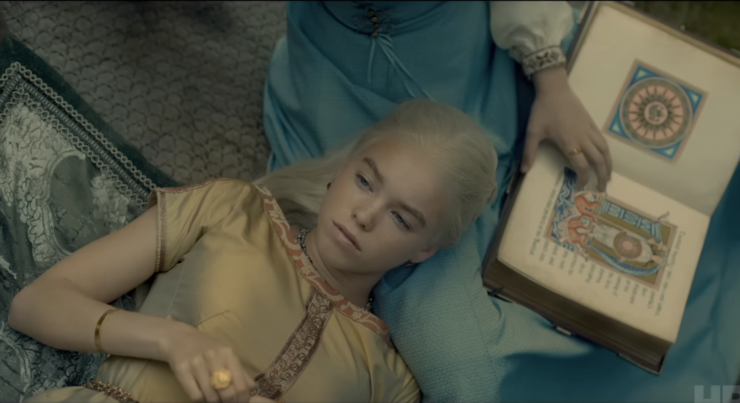
The climax of episode 8 sees Alicent Hightower grabbing a storied knife—the dagger that will eventually kill a manifestation of icy death and horror in Game of Throne’s climactic moments—and rush at her childhood friend. Both women wrestle with one another, hurling insults about how the other has failed in an essential performance of their role at court: Rhaenyra is a willful, privileged brat; Alicent is a self-righteous, conniving schemer. Meanwhile, all the prideful, manipulative, ineffectual, and calculating men in their lives—King Viserys, Otto Hightower, Daemon Targaryen, Criston Cole, Corlys Velaryon, Larys Strong—stand on the sidelines, gawking at the spectacle of a high-powered cat-fight with horror, fascination, and contempt. It is as stark a literalization of the show’s thesis as anything: women, no matter how powerful or resourceful, will be used as pawns of the patriarchy and then blamed for playing the roles men have forced upon them.
House of the Dragon gets to this point by making some clever changes from Martin’s original. Rhaenyra and Alicent are both fixtures of court in Martin’s book, but nearly nothing is given about their relationship with one another before we meet them as bitter rivals pushing opposing claims to the Iron Throne. In fact, the Alicent Hightower of Martin’s book is eleven years older than Princess Rhaenyra. By spending half a season with younger versions of both women and showing their earnest early friendship (and its sapphic undertones) as a messy, passionate, desperate desire to connect, House of the Dragon has set up the rest of the series to read as more than a bloody succession crisis waged between two smart and ruthless women. Instead, it becomes an epic, kingdoms-wide tragedy about the ways in which two women, manipulated and abused by the patriarchal pressures of the men in their life, are placed at each other’s throats, unable to act on the love and connection that should bind them together. It will serve as a reminder in all the seasons to come of what could have been.
Special attention should also be paid to Milly Alcock and Emily Carey (young Rhaenyra and young Alicent, respectively). Both actors are absolutely phenomenal in a cast that boasts a quite a number of fantastic performances. The original Game of Thrones benefited from an impressive array of extremely talented child actors (including Sophie Turner, Maisie Williams, Bella Ramsey, and Jack Gleason, who all became household names at some point) and, though Alcock and Carey were both legal adults at the time of filming, the tremendous performances of two relative newcomers anchoring the first half of the season mirrors that special luck that the franchise has always had with younger actors.
The fact that Alcock and Carey are young adults working with the benefit of intimacy coordinators on set and a writers’ room mandate to not depict sexual violence also solves a long-standing problem with the original show. If there was one thorough and consistent failing in the original, it was the repeated use of rape as a storytelling device, especially in the arcs of some of its younger cast members. The fact that House of the Dragon seems to be conscientious about not portraying graphic rape without once dulling its sharp critique of patriarchy puts the lie to the idea that sexual violence is a necessary plot device when discussing male privilege and power. It’s a welcome change, and a testament to how much more nuanced and interesting storytelling can get when there are more women in the writers’ room and in the director’s chair.
Grief at the Fore
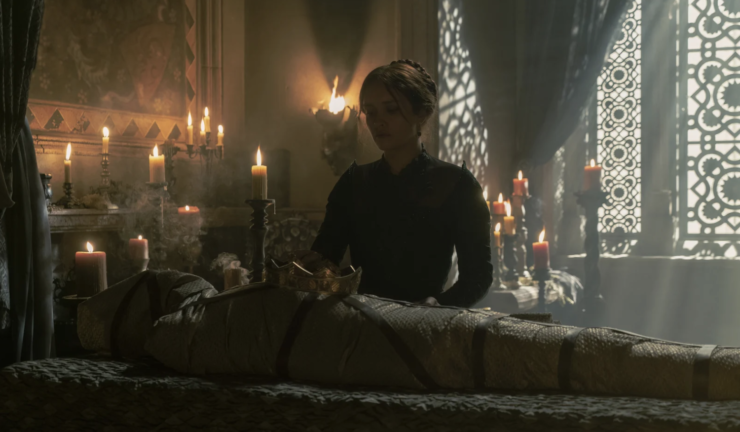
One unexpected facet of the show that works to elevate Martin’s original is how much this first season has been a meditation on grief and the many ways in which it can strengthen or poison relationships.
The Viserys of Fire & Blood is an inoffensive fool, unable to see the discord he is sowing, whose death shatters the realm because he has refused to act; he’s King Lear without the Storm. Certainly that is not completely at odds with the show’s characterization, but they have given the character a deep well of sadness. I wrote, in my review of the pilot, that Viserys displays a callous ruthlessness in refusing to tell Aemma Arryn that she will die. I was wrong. Viserys is full of cowardice and hesitancy, but he acts primarily out of grief—grief for the beloved wife he lost, for the daughter who does not trust him, for the new wife whose marriage to him he cannot fathom is not her choice. Paddy Considine anchors Viserys with a sweetness and a profound sense of regret that gives his every action, no matter how wrongheaded or shortsighted, a kind of relatability that makes the most powerful man in the realm feel like a victim worthy of our pity. When he makes his final plea for his family to love each other, it’s suffused with all the primal, distinct flavors of grief—anger, hope, sorrow, and a touch of quiet warmth. Calls to award Considine an Emmy for his performance don’t feel overblown.
Otto Hightower, too, is a fascinating study in the ravages of grief. Rhys Ifans is excellent at presenting a neutral, dead-eyed face that, nevertheless, communicates a wide range of emotional nuance. There are long stares, mouth slightly agape, face stony, where you can see a glimpse into Otto’s grief-stricken soul—but at every turn, his loneliness has hardened his ambition and given him license to be quietly cruel to his daughter. Ifans lets just a bit of his widower sadness out, even when he tells Alicent, herself a grieving child in need of her remaining parent’s love, that she should wear her mother’s dress and use that grief to seduce the King. And through it all, he manages to look wounded by it. Otto Hightower is a monster, but Rhys Ifans manages to wordlessly convey that he believes all his machinations are done out of a kind of grim, joyless duty—necessary evils that he must sorrowfully take on. In the rare moments when he tries to connect with Alicent (be it praising her attempt to stab her oldest friend or telling her that in certain lights, she looks just like her mother), it’s twenty-five years too late and the gesture is deeply out of touch. All Alicent can do is roll her eyes, understandably unable to separate his sense of loss from his nose for opportunity.
Tragedy, Nuance, and Disappointing Men
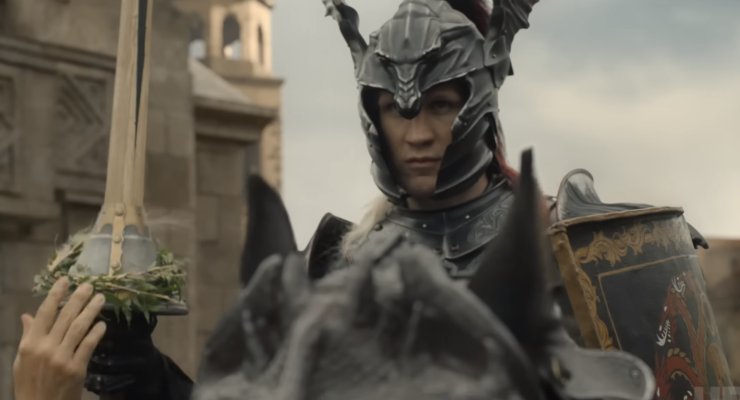
The original series fell, generically, between a political thriller and a fantasy epic. By the final seasons it was leaning into the latter and—instincts for brutal character deaths notwithstanding—the showrunners left us with a tale of a few basically good people trying to make a terrible world better. It played well into Martin’s desire to get his readers to empathize with characters initially set up to be detestable. This was the subject of my first ever article for Tor.com and the original show was excellent at following up on that particular facet of A Song of Ice and Fire; we were conditioned to hate figures like Jaime Lannister and Theon Greyjoy, but both books and show expertly humanized, complicated, and endeared them to us to a degree we could never have expected.
House of the Dragon, on the other hand is structured as a tragedy—fitting for a story about how hubris and ambition bring an end to a golden age and seventy years of peace. It cannot promise us any semblance of a happy ending. Even in the shared universe of the two shows, a huge part of the ending of this period in history has already been described (don’t rewatch the later seasons of Game of Thrones if you don’t want some major events spoiled). I’m not actually sure what moment from Fire & Blood the series might end on, if the desire is to leave the audience with anything but a cathartic sob. Likewise, its project with regard to character development must be the inverse of Martin’s original. The question is not, “How might we come to understand and love a flawed and supposedly irredeemable character like Jaime Lannister?” but rather, “How do the characters we root for end up doing such despicable things?” How does sad, duty-bound, compassionate Alicent Hightower become a manipulative, usurping fanatic? How does clever, playful, kind-hearted Rhaenyra Targaryen become a ruthless, cunning despot? That is a harder project to get behind, but it’s one that the show is making smart decisions about—if only to twist the knife they’ve already stabbed us with.
There is also an advantage to this kind of tragic study in failure when it comes to the show’s more irredeemably awful characters. Too often, nuance in storytelling becomes a byword for redemption. A text that makes the case for humanizing a rapist or a war criminal or a serial killer risks muddying the point that being held accountable for their actions is necessary even when we feel something beyond loathing for these characters. On a show like this one, where likability and empathy and pity don’t correlate with moral fortitude, one can have a lot more fun giving us nuanced villains whose arcs feel safely unredemptive.
When everyone is wrong, you can also give your nuance some teeth. Alicent’s desire to lean in when it comes to Westerosi patriarchy rings false when she confronts Rhaenys Velaryon (Eve Best) who retorts with a faux-Medieval version of Audre Lorde’s famous declaration that “the master’s tools will never dismantle the master’s house.” But later in that same episode, one cannot help but be reminded that Alicent outlined her values as harm reduction—“a true Queen counts the cost to her people.” She may be toiling in the service of men, but she has a point. Rhaenys spares Alicent and Aegon when she escapes the Dragonpit but doesn’t count any of the cost paid with the lives of the few dozen smallfolk her dragon murders. Feminism may have come to Westeros, but it’s still classist as all get out.
Perhaps that approach—thoughtful arguments espoused by deeply flawed characters-–is why this first season has been so good at illuminating all the different kinds of disappointing men who don’t acknowledge their role in the horrors of patriarchy. Drunken, self-pitying, serial rapist Aegon Targaryen (Tom Glynn-Carney) is allowed twinges of pathetic (in both senses of the word) vulnerability talking about how keenly he feels his parents’ contempt for him. As he raises his family’s ancestral sword to a cheering crowd at his coronation, we get to experience a cavalcade of conflicting emotions as the previously unknown joys of being adored blossom on his face, even as the music tells us that nothing good will come of his being king. Ewan Mitchell, playing the adult version of sociopathic, kinslaying Aemond Targaryen can lean into his hulking, inevitable, slasher-film villainy having been so expertly set up by Leo Ashton’s earlier turn as the younger version of Alicent’s second son: relentlessly bullied for his attempts to live up to his royal duties by being a generally weird, stuffy little kid. A glimmer of that lost little boy manifests for just a second in the moments after killing his nephew, as Aemond realizes that everything has gotten out of hand and he has truly screwed things up past the point of all return.
Criston Cole’s good looks and rakish charm become be a dissonant through line as his chivalric virtue curdles into self-righteous pomposity; romantic bravado proves to be only a few steps away from a chauvinistic madonna-whore complex, and breathless daring doesn’t really look that different from a murderous temper. Daemon Targaryen gets to be both a self-centered drama-monger and also—okay, look: I don’t understand why the internet seems to go so wild for Smith’s portrayal of Daemon. He’s excellent as a brutal, sneering, arrogant agent of chaos who never misses an opportunity to make a bad situation worse and he has teeth-clenchingly wild chemistry with both Milly Alcock and Emma D’Arcy but…fine, okay, maybe I get it. I may not wholly be on board with Matt Smith as the internet’s bratty new boyfriend, but Daemon fulfills all of the queasy unease of a bad man in power. He encompasses all of Joffrey Baratheon’s petulant unpredictability and cruelty but manages to be consummately charming and weirdly hot in a C+ white wig.
Dragons!
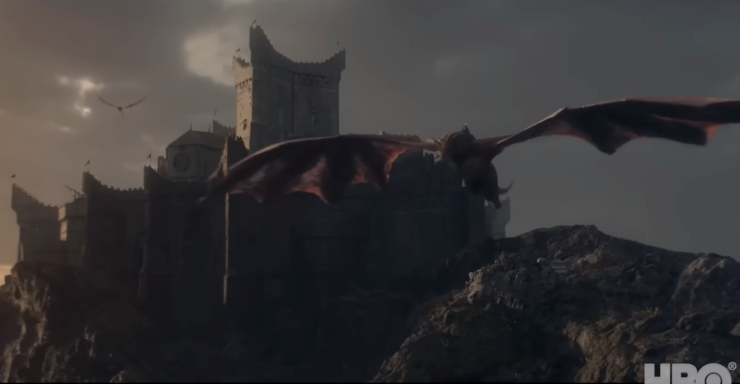
Martin famously dedicated 2000’s A Storm of Swords to “Phyllis, who made me put the dragons in.” He has since clarified that very early versions of the novel took place in a world where dragons didn’t exist. That’s believable insofar as the first few books of A Song of Ice and Fire feature dragons very little (up through A Storm of Swords the creatures are treated as, essentially, very valuable bargaining chips). HBO’s original Game of Thrones series was also quite sparing with its dragons for the majority of its run. And while it had undoubtedly cool moments, Daenerys Targaryen’s children always seemed like a half-finished project: the design of all three was nearly identical and their distinctly described colors were muted enough that it could be difficult to tell them apart. I don’t even think Viserion’s name was mentioned on the show until the episode after his death (especially galling for me since that’s my cat’s name).
House of the Dragon, on the other hand, has reveled in its dragons. This is, in part, due to the new show’s higher VFX budget when compared with early seasons of GoT, but there also seems to be genuine love and care taken in making each of them spectacular and individual. Caraxes’ deep blood-red coloration and his long, serpentine neck give him a sinister conniving presence that matches Daemon for uneasy-making gravitas. Syrax’s slender, back-curving horns look elegant and surprisingly delicate for a huge, fire-breathing beast. Meleys has a wonderfully barbaric looking crown of horns that work to retroactively justify her nickname, “the Red Queen.” And of course there is the excellent Vhagar—a by-turns endearing and terrifying kaiju, whose pendulous iguana wattle, nearly hornless head, and massive, wrinkled bulk all bespeak her position as the ornery dowager of the Targaryen brood.
Beyond this evident love manifesting in the dragons’ design, the show has done an excellent job of integrating them into the plot. The final sequence of this season, with Aemond Targaryen on Vhagar’s back stalking after his nephew Lucerys, riding the tiny, nimble Arrax, was scary, thrilling, and gorgeous. As the Dance of the Dragons moves from looming crisis to all-out war, it seems inevitable that the dragons will be put to spectacular use, fulfilling the promise of dark high fantasy being fought out on dragonback that the original series doled out in the tiniest morsels.
What Season 2 Could Do Better
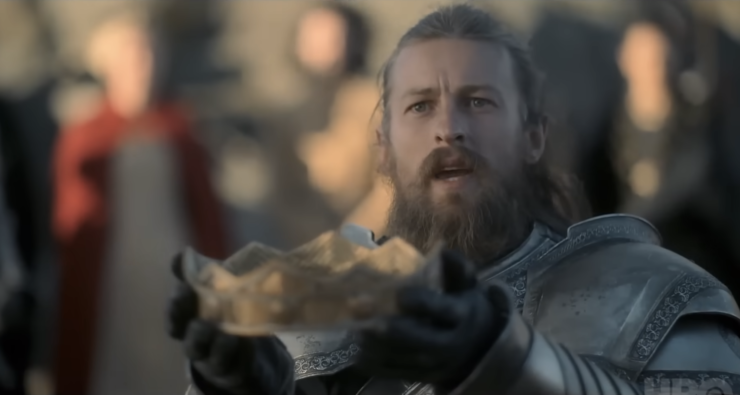
A Sense of Humor
The original Game of Thrones series was certainly grim and often full of blood-soaked tragedy but it had a clear sense of humor and actors who could provide levity without altering the tone too much. For every two Jons Snow or Daeneryses Targaryen, there was a clever Tyrion, a sardonic Cersei, a deadpan Sandor Clegane who could be counted on for a tension-breaking quip. Most of the humor in Fire & Blood comes from Mushroom, the court fool, who serves as one of Archmaester Gyldayn’s unreliable narrators. Ryan Condal has confirmed that Mushroom had been cut from the show, a decision I think is wise, given the possible ableist read of the character (a little person played entirely for mockery and licentiousness has the possibility of being deeply unpleasant). But with no replacement, the show faces the possibility of becoming an unpleasant slog. Happily, there are a couple of characters who might be introduced in later seasons that could serve as some sort of counterpoint to the machinations of royal claimants, even if they will bring something more akin to the darkly humorous amorality of a Bronn than the joke-telling and potshot-taking jocularity of a Tyrion.
More Conscientious Casting
When the show first announced the casting of Steve Toussaint as Corlys Velaryon I was thrilled. Portraying a multi-racial Valyria is an important bit of representation, especially when the previous show was rightly criticized for casting people of color, almost exclusively, as slaves, pirates, and barbarians, with very few exceptions. That said, it has been, at times, uncomfortable to see the representation promised by having Velaryons of color result in characters that are disproportionately killed off or sidelined. Critical Role’s Aabria Iyengar, summed it up best in a tweet, discussing the ways in which seeing Black characters as power players in Westeros was soured by how consistently they were force to bear the brunt of the show’s brutality. I would say that this problem is somewhat compounded by the attention given, at season’s end, to Rhaenys. Don’t get me wrong—Eve Best is a phenomenal actor and the character is dynamic and well-written–but having the White matriarch of Westeros’ most prominent Black family be the only one doing anything effective or thoughtful in your first season cuts against the power of the show’s initial casting choices. Add to that, casting Sonoya Mizuno, the first Asian woman to be cast as a lead on any Game of Thrones show, as a sex-worker turned spy and one can see that there is still plenty of work to be done.
There are more Velaryons yet to be cast as the show progresses, however, and Corlys Velaryon, alongside his granddaughters, have larger roles to play which will hopefully help with improving on this show’s track record. There are good instincts at play on House of the Dragon and the choice to put actors of color in roles that could have been cast with White people (Kurt Egyiawan as Grand Maester Orwyle, for example) shows that there is plenty of room to make Westeros look more like the real world. At a time when racist nonsense condemning the casting of Black Mermaids and Afro-Latino Elves pollutes the discourse surrounding fantasy media and comes not just from random white supremacist trolls but also from one of Martin’s longtime collaborators, it has never been more important for House of the Dragon’s showrunners and casting director to push back and be thoughtful and aggressive in making Westeros a world in which everyone in fandom can hope to see themselves represented.
Pacing
The structure of Fire & Blood is an odd one for adaptation. The meat of the tale the series is seeking to tell takes place over the course of about three in-universe years (which are covered in the original novella, The Princess and the Queen) but, in order to give the story the necessary context, one needs to look at about thirty years of history leading up to the Dance of the Dragons. Using the first season to cover most of that time, complete with time-jumps of between six months and ten years between all but the last three episodes, was a bold choice but one that left many viewers reeling. Rhaneyra, Alicent, and their children were all recast at least once during the first season, and Laena and Laenor Velaryon were each recast twice. The show handled these shake-ups with a certain amount of dexterity, but some episodes—particularly the sixth, which the showrunners referred to as a “second pilot,” meant that people played catch-up across years of history rather than being in the moment with the next chapter. Now that the show has settled into a pace that should (if they follow the source material) be slightly slower than real-time (with the next proposed three seasons taking about two years total), another adjustment seems inevitable.
In addition to the whiplash of time-jumps, the show’s limited time frame also meant that some plot points were glossed over too quickly and others felt oddly drawn out. Rhaenyra and Harwin Strong’s (Ryan Corr) relationship seemingly came out of nowhere with the ten years of their affair established through exposition and his death coming at the end of the only episode in which he is featured for more than a single line. Similarly, Laena Velaryon was given a lot of tantalizing buildup, with key scenes from both her childhood and her teenage years making an impression on viewers. This leads to less than ten minutes of screen time with Laena as an adult before she expires. All of this without even touching on the fact that Alicent and Viserys’ fourth child, Daeron Targaryen, has gone unmentioned but has not, apparently, been cut been cut from the show entirely. Hopefully, the more even pacing of the plot to come will result in a second season that is not quite as jarring as the first.
***
I love Martin’s Song of Ice and Fire books immensely. I loved the original Game of Thrones series and, even if some of its storytelling fell short in the last few seasons, I still found plenty of things to adore (I will argue that Season 8’s “A Knight of the Seven Kingdoms” ranks among the finest hours the show ever produced). It should come as no surprise then, that I love House of the Dragon. In my review of the first episode, I said that there was reason for cautious optimism going forward. At season’s end, I feel safe in saying that House of the Dragon compares favorably with the best of the original series. After three years of lamenting the ways in which Game of Thrones fell short of the (perhaps unreasonable) hype for its ending, I feel fairly sure that this series will be capable of telling its story with a comforting consistency. Its scope is smaller, its politics are nastier, and its overall tone is (somehow) much more of a downer, but Condal seems up to the task of ensuring that the rest of this era of Westerosi history goes the way Martin intended—whether or not you think that is a good thing is surely a matter of taste.
All in all, House of the Dragon is exactly the kind of show we needed to both remind us of what made the original Game of Thrones great, and at the same time improve on its shortcomings—as well as finally giving us the dragons we have always deserved.
So, what did you think of the finale? Are you excited for more dragon battles and bloody betrayals next season? Let me know in the comments below!
Tyler Dean is a professor of Victorian Gothic Literature. He holds a doctorate from the University of California Irvine and teaches at a handful of Southern California colleges. He is the author of “Distended Youth: Arrested Development in the Victorian Novel” and his article “Exhuming M. Paul: Carmen Maria Machado and Creating Space for Pedagogical Discomfort” appears in the most recent issue of Victorian Studies. He is one half of the Lincoln & Welles podcast available on iTunes or through your favorite podcatcher. His fantastical bestiary can be found on Facebook at @presumptivebestiary.










